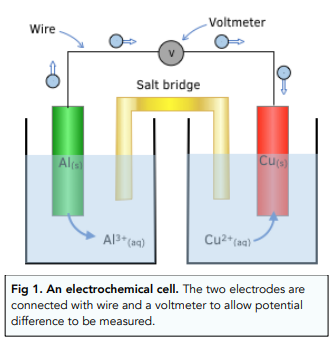Electrode Potentials and Electrochemical Cells - Representing Electrochemical Cells (A-Level Chemistry)
Representing Electrochemical Cells
Representing Electrochemical Cells
IUPAC (International Union of Pure and Applied Chemistry) came up with some conventions for representing electrochemical cells. Understanding these conventions is fundamental to chemical engineering, a field where such principles are applied in designing and optimizing processes, often observed firsthand during Chemical Engineering work experience.
An electrochemical cell can be represented in a diagram, as shown above in figure 1:

In addition to diagrams, cells can also be represented written down in shorthand form:

The following conventions are used to represent the cell:
- Double vertical solid line = salt bridge
- Vertical solid line = phase boundary, e.g, between an aqueous solution (aq) and a solid (s).
- Species with the highest oxidation state = written closest to the salt bridge (the double vertical line).
- The half cell with the more negative potential = goes on the left
- Platinum electrode is used when there are no solid electrodes in the half cell.
Worked example:

A half cell containing Fe³+ and Fe²+ ions is connected to a half cell containing acidified manganate (VII) ions.
Use the standard electrode potentials to write the correct cell notation.
Answer:
The MnO4- half cell has a more positive electrode potential and therefore the reduction reaction will occur. This cell will be placed on the right.
Fe²+ ions will be oxidised to form Fe³+ ions. This half cell will be placed on the left hand side.
As there are no solids in either half cells, platinum electrodes are needed in each.
The cell can be represented by:-






Still got a question? Leave a comment
Leave a comment